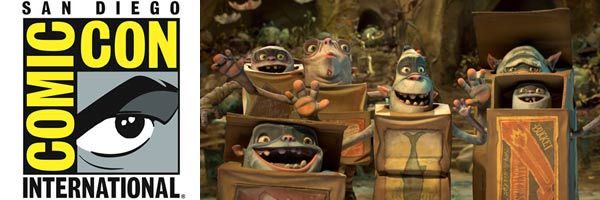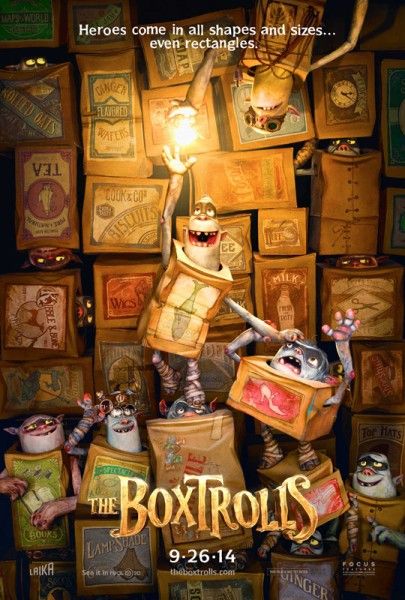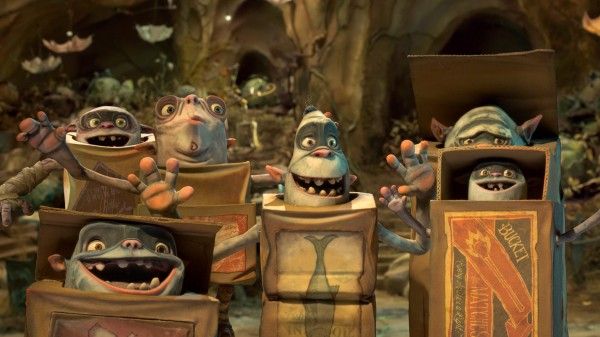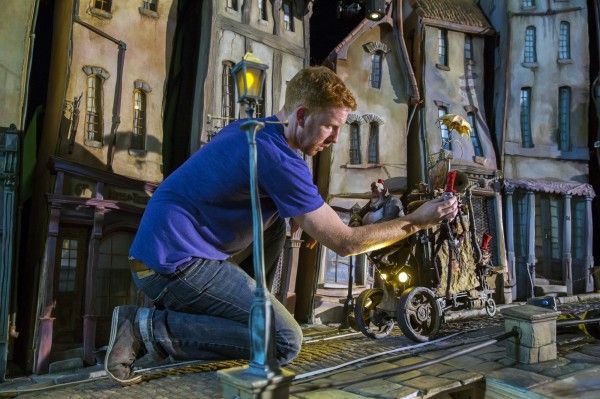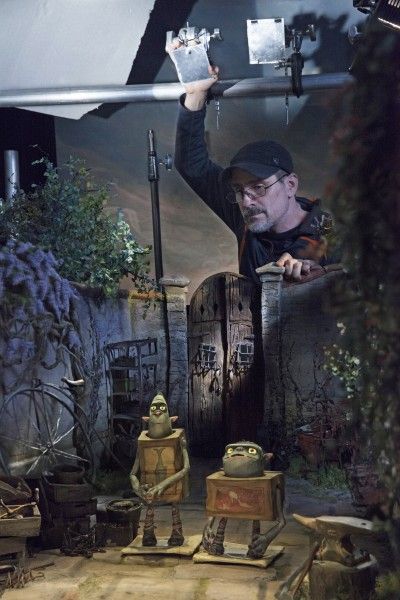The Boxtrolls is one of my most-anticipated films of the fall. LAIKA is one of the most exciting studios working today because they’re the only one wholly committed to the beautiful art of stop-motion animation. But beyond their medium, they’re telling rich, interesting stories about weird outsiders traveling through strange worlds. The Boxtrolls looks like their most ambitious yet, and today’s Comic-Con panel made me even more eager to see this strange, gorgeous movie.
Hit the jump for The Boxtrolls Comic-Con panel recap.
Panel Highlights
- Panelists: Travis Knight (animation supervisor), Anthony Stacchi & Graham Annable (directors), Isaac Hempstead-Wright (Eggs), Elle Fanning (Winnie Portley-Rind), and Sir Ben Kingsley (Archibald Snatcher)
-
They directors wanted Ben Kingsley because of Sexy Beast and thought he would make a great voice for a memorable villain like Snatcher. “I think anyone who is constantly passed over by life,” says Kingsley, “…is hugely vulnerable.” So the character has to invent a world he can conqueror. So it’s a desperation that’s covered up by bravado.
- The moderator notes that Snatcher is very funny, and it’s reminiscent of the comedy Kingsley did Iron Man 3. Kingsley says he loves making people laugh and he used to do a lot of comedy on stage early in his career and he hopes to keep doing more.
- When Fanning is asked if she had any conversation with sister Dakota who did the lead voice on Coraline, she notes that Dakota’s performance was done over the course of many years because it takes so long to do stop-motion plus it was LAIKA’s first movie. Fanning remembers going down to LAIKA when she was little, and then coming back for The Boxtrolls and seeing how they had evolved. She mentions a woman whose job is knitting tiny sweaters. “Everything is unbelievable. It’s just a whole ‘nother world.”
- Fanning said she wanted to make sure her British accent was right, so she got a dialect coach and worked with her in the recording booth.
- How was it for Hempstead-Wright to only use his voice? He shares Fanning’s sentiment about how if you don’t have the voice, you don’t have the character. He would also do “Vox” which are vocalizations like screaming, shouting, and even licking noises. Fanning says there’s one point where her character is muffled, so she had to do that in the booth.
- They had to tone down the cheese stuff from the book like cheese running around Cheesebridge.
- The boxtrolls’ form of “applause” is rapping their fists on their boxes, and that was something that was created by the animators as opposed to something from the book.
- A lot of the sets they create for the movie end up getting destroyed in the filming process because those sets have be to be carved up for the camera to move around. For example, as the camera moves in to get close-ups, the set has to be pulled apart. Things that haven’t been destroyed are sometimes sent to museums.
- When it comes to props they wanted to keep from the movie, Hempstead-Wright says he wants the “mega-drill” (Stacchi informs him that it’s 5-feet tall “and weighs a ton”). Fanning wanted some of the cheeses. Kingsley wanted a puppet of Snatcher to open his front door and greet his guests.
- When they first recorded Tracy Morgan, he did it in his normal voice, but joked he had been practicing a British accent for a long time. Morgan would also keep saying, “I can’t believe I’m doing a movie with Sir Ben!” Mr. Gristle was originally a small character, but Mogran’s ad-libs made them add more of the character to the movie. “He’s like a Victorian Terminator,” says Knight, and Stacchi says the character has a habit of narrating what he’s doing.
Audience Q & A
-
Actors’ favorite scene to do? Fanning says it’s when Winnie first goes into Boxtrolls’ underground lair because she is so loud and angry and demands to know where are the horrors she’s been led to believe exist. Hempstead-Wright also likes that scene because Eggs tries to explain why he’s a boxtroll even though he’s a human (for example, when asked why he can talk and boxtrolls can’t, he replies, “I have a speech impediment!”). Kinglsey says his favorite moment is when Snatcher meets the mayor and, “tries to wheedle his way into high society.”
- How did LAIKA come into being when it takes so long to make their movies? Knight says they get 1-2 minutes of footage per week, so it takes a year and a half to complete a film. But development takes years. He also notes that he loves finding materials for the world (“We used a lot of hemp,” Knight says to the cheers of people who like pot innuendo) but can also use advanced technology like 3D printers.
- Other challenges of stop-motion? “It’s horrible!” says Knight. “It’s contorting your hands, burning yourself. It’s terrible.” But ultimately it’s beautiful because everything is designed built and used by artists, he says. It also combines everything he loves with regards to art, music, performance, etc. “It’s worth the pain.”
- Did Dakota Fanning give Elle Fanning any advice? No, because with her and her sister, they’re very separate in their work ways. Dakota was happy for Elle, but let her sister do her own thing. “She has Coraline and I have Winnie,” says Elle.
- What drew LAIKAs to darker, more twisted stuff? The best kind of storytelling is dynamic storytelling says Knight. He feels that dynamism is missing from many movies, and while their movies are different, he feels that kind of dynamic storytelling is in their DNA.
- Do the actors find it limiting or freeing to just do voice acting? Kingsley says it’s more freeing because the puppetry allows a figure to take a performance beyond physical limits and the voice follows. Hempstead agrees because it’s great to go 100% with their own voice. Fanning likes it because she’s really into all the details of voice acting. Knight says there’s an art to doing good voice acting, and there aren’t many who can hone everything down to one instrument.
- Is it harder when you’re the only person in the room? Kingsley says it’s good to imagine what you’re playing off, but you have to push your imagination to the limits because so much of acting is being able to work with other actors in the same physical space.
- What program do they use to edit stop-motion and what’s the re-editing process? First they storyboard everything, and those are edited together on the Avid. Once they finish out the comic timing, they record the final pieces of dialogue, and do the re-editing. Then they can prepare the faces of the puppets. But in stop-motion, you “launch” the animator into the scene, says Stacchi, because in stop-motion, your puppet has to match everything and figure out the whole series of movements in one shot. As for the tools, they use Canon 5D for the camera, and Dragon as the software. This is widely available, unlike when they were younger as “nerds in isolation in our parents’ basement,” says Knight.
- The Boxtrolls was shot natively in 3D and was designed for that technology.
-
What’s the difference between the stop-motion materials and the CGI? They try to use as much materials as they can, but sometimes so you can’t. For example, there’s a ballroom scene, and you couldn’t physically build all puppets so they used background CGI puppets.
- Live-action set design for stop-motion animation is the same as regular live production. “It’s just smaller,” says Stacchi
- Some of the footage was brought to the actors to help inform their performances.
- Scripts for animation are usually very fat so they have a lot of descriptions right down to having a growl or a grunt so that the actor could have it. “But,” Knight says, “we don’t have farts. We’re not DreamWorks Animation.”
- Do they have plans to use more 2D animation in the future? “We’re obsessed with using a variety of technics, and they’ve used 2D animation in all of their movies, and plan to keep doing so in the future. Knight also mentions he has a long-held dream of doing a 2D-animated feature.
Footage
We were treated to an extended featurette that blended showing the remarkable about of behind-the-scenes humor, briefly seeing the incredibly talented voice cast do some recording, and then the warmth and comedy we can expect from the finished feature. The overall plot shows that Eggs is a young boy who was raised by boxtrolls and thinks he’s one of them. His arc is trying to learn how to act like a normal human, but as animation supervisor Travis Knight points out, sometimes it’s about making the world fit your weirdness. So there’s also an aspect about trying to correct the boxtrolls’ public perception. The villain Archibald Snatcher has managed to convince the people of Cheesebridge that boxtrolls are vile, violent creatues, when actually they’re shy, timid scavengers who stay hidden as a defensive mechanism.
I don’t know if this extended featurette will end up online, but if you watch both the featurette that’s been released along with the trailers, you’ll get a good sense of what we got in Hall H. For me, what was shown made me even more excited to see this movie because not only is LAIKA continuing its trend of making strange, weird, charming films, but with The Boxtrolls, it looks like they’re continuing to refine and hone that style.
Later in the panel, we were treated to a sequence that’s almost entirely dialogue free. In the sequence, the boxtrolls are doing some scavenging, and they fight over some pieces of junk, but the boxtroll Fish finds a teddy bear that he decides to keep. Their scavenging is interrupted when Snatcher and his goons come across their location. The boxtrolls manage to scurry away and get underground. Once there, Fish gives the teddy bear to the infant Eggs, who promptly rips the bear’s head off so he can get to the music box inside. It’s a cute scene, but what’s remarkable about it is the level of detail that went into the boxtrolls’ underground home. I also loved the little details like when the boxtrolls go to sleep, they stack on top of each other. They recreate the feel of stars by having all the lights go out except the ones they hang from the celling.
Right before the end of the panel, they showed us a clip where henchmen Mr. Pickles (Richard Ayoade) and Mr. Trout (Nick Frost) wax philosophical about being moved about giants, and the camera moves back with to reveal Knight superimposed over moving the puppets, and it’s a really neat scene to see how much works is required, but it’s also funny since Pickles and Trout are making a commentary on stop-motion animators. “Seems like more of a hobby than a job,” says Mr. Pickles.

